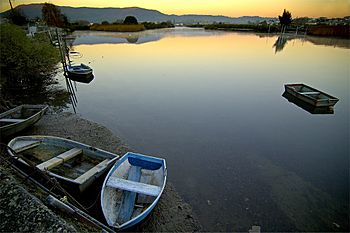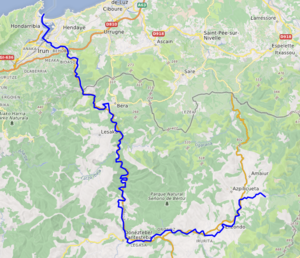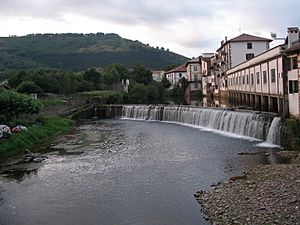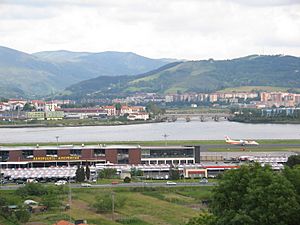Bidasoa facts for kids
Quick facts for kids Bidasoa |
|
|---|---|

The Bidasoa in Spain
|
|
 |
|
| Countries | |
| Physical characteristics | |
| Main source | Western Pyrenees |
| River mouth | Bay of Biscay 43°22′22″N 1°47′31″W / 43.37278°N 1.79194°W |
| Length | 66 km (41 mi) |
| Basin features | |
| Basin size | 705 km2 (272 sq mi) |
The Bidasoa is a river that flows through the Basque Country in northern Spain and southern France. It mostly runs from south to north. The river gets its name downstream from the village of Oronoz-Mugairi in Navarre. However, it actually starts when several smaller streams meet near the village of Erratzu. The stream called Baztan, which begins on the side of Mount Autza, is considered the main source of the Bidasoa. The river eventually flows into the Cantabrian Sea (part of the Bay of Biscay) between the towns of Hendaye in France and Hondarribia in Spain.
The Bidasoa river is famous because its lower part forms the border between France and Spain. Many important travel routes cross this section of the river. These include major highways like the AP8, main roads, and important railway lines from both France (SNCF) and Spain (RENFE). There are also regional train lines, like EuskoTren, and the historic Santiago Bridge. This bridge is used by both pedestrians and vehicles, and it's part of the famous Way of St. James pilgrimage route. In this part of the river, you'll see a lot of buildings and city areas.
Before the Bidasoa reaches the ocean, it forms a bay called Txingudi. This bay is located between Hendaye, Hondarribia, and Irun. In 2002, Txingudi was recognized as a Wetland of International Importance. It covers an area of about 1.28 km2 (0.49 sq mi). Near Hondarribia, you'll find the small San Sebastian Airport, which handles domestic flights.
What's in a Name?
The Bidasoa river is a place where different languages meet. Because of this, its name is said differently depending on the language. In Basque, it's pronounced bi'ða's̺o'a. In Spanish, it's biðaˈs̺oa, and in French, it's bidasɔ'a.
Experts who study language and history believe the name comes from an old Latin phrase, "Via ad Oiassonem." This phrase means "road to Oiasso." It's thought that a Roman road connecting the Basque town of Pompaelo to Oiasso might have run along the river. Over time, "Via ad Oiassonem" changed into the Basque name "Bidasoa."
Where the River Flows

The Bidasoa river is about 66 km (41 mi) long. Most of its journey is through the Spanish region of Navarre. Only the last 10 km (6.2 mi) of the river forms the border between France and Spain. This part also marks the boundary between the Basque provinces of Gipuzkoa and Labourd.
Most of the land that drains water into the Bidasoa (its watershed) is in Navarre. This area is about 684 km2 (264 sq mi). The river basin has 105 permanent streams and smaller rivers, totaling 497 km (309 mi) in length. This region gets a lot of rain regularly. About 22,000 people live in the rural parts of the Navarrese side of the basin. It's good to know that 70% of the wastewater from these homes is treated before it goes into the river.
For its first 15 kilometers, the Bidasoa flows from north to south, similar to other rivers in Gipuzkoa that also flow into the Bay of Biscay. After collecting water from the Belate pass, the river turns north. It flows through the town of Bera at the northern end of Navarre. Then, it enters Gipuzkoa at a place called Endarlatsa. From the town of Doneztebe onwards, a main road (N-121) follows the river all the way to the estuary.
The main rivers that flow into the Bidasoa are smaller ones like the Zeberia (10.80 km (6.71 mi) long), Ezkurra (20.90 km (12.99 mi)), Latsa (11.10 km (6.90 mi)), and Endara (9.90 km (6.15 mi)). Many other small streams also add their water to the Bidasoa along its path.
Fish and River Health
The part of the Bidasoa river in Navarre is a popular spot for people who love to fish. The river is home to many native fish species. These include eels, salmon, trout, bullhead, and minnow. You can also find gudgeon, sea lamprey, allis shad, flounder, and grey mullet. Some of these fish, like the bullhead and salmon, are very important and are considered endangered.
However, too much fishing has become a big problem for the river's wildlife. Salmon, in particular, face challenges when they try to swim upstream to lay their eggs. Many don't make it. They might be caught by fishers, or they might not be able to get past the many hydroelectric power stations and dams along the river. There are 128 power stations and 114 dams, and 63% of these dams block the path for fish trying to migrate. The government of Navarre is working on plans to help solve these problems and protect the river's fish.
See also
 In Spanish: Bidasoa para niños
In Spanish: Bidasoa para niños
- List of rivers of Spain
- Battle of the Bidassoa (1813)
- Bidasoa-Txingudi
- Pheasant Island (Île des Faisans)





